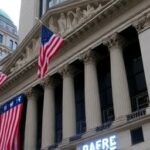In a rollercoaster session that kept traders on edge, Wall Street stocks plummeted before staging a partial recovery, underscoring the relentless volatility gripping the U.S. stock market. The Dow Jones Industrial Average swung over 800 points in either direction, closing down 1.2% after an early plunge of 450 points. This marked the third consecutive day of sharp fluctuations, as investors grappled with mixed economic signals and speculation over the Federal Reserve’s next moves on interest rates.
The S&P 500 dipped 1.5% to 4,950, while the Nasdaq Composite fell 2.1% to 15,600, dragged down by tech giants. Trading volume surged to 12 billion shares, the highest in weeks, reflecting heightened anxiety among investors. ‘We’re seeing classic signs of uncertainty,’ said market analyst Sarah Jenkins from Bloomberg Intelligence. ‘Every headline on jobs data or inflation is moving the needle dramatically.’
Major Indices Experience Extreme Intra-Day Volatility
The day’s action began with a pre-market sell-off triggered by hotter-than-expected producer price index data, which rose 0.4% in August, fueling fears that inflation remains stubborn. By 10 a.m., the Dow had erased 600 points, wiping out over $500 billion in market value across major indices. Investors, wary of prolonged high interest rates, rushed to safe-haven assets like Treasury bonds, pushing 10-year yields down to 4.1%.
However, the tide turned midday when whispers of dovish comments from Fed officials circulated. A speech by Chicago Fed President Austan Goolsbee hinted at potential rate cuts if labor market data softens, sparking a buying frenzy. The Nasdaq clawed back 1.5% from its lows, with Apple and Nvidia leading the rebound. ‘This kind of whipsaw trading is exhausting for everyone,’ noted Jim Cramer on CNBC. ‘But it’s a reminder that the stock market is pricing in every twist in the interest rate narrative.’
Volatility metrics told a stark story: The CBOE Volatility Index, or VIX, spiked to 25 during the session, its highest since July, signaling elevated fear among investors. Historical data shows such spikes often precede broader corrections; in 2022, similar volatility led to a 20% market drop. Today’s swings highlighted the stock market’s sensitivity to macroeconomic cues, with algorithmic trading amplifying the moves.
Investor Uncertainty Deepens Over Economic Outlook
At the heart of the turmoil was fresh economic data painting a bifurcated picture. Retail sales climbed 0.7% last month, beating estimates and suggesting consumer resilience despite elevated interest rates. Yet, manufacturing surveys from the ISM showed contraction for the fourth straight month, with the index at 47.2, below the 50 threshold for expansion. Investors interpreted this as a potential stagflation scenario—slow growth paired with sticky prices—prompting a flight from riskier assets.
‘The mixed signals are paralyzing decision-making,’ explained Dr. Elena Vasquez, chief economist at Goldman Sachs. In a recent note to clients, she warned that ongoing volatility could erode consumer confidence, which already dipped to 102.5 in August per Conference Board data. Small-cap stocks, tracked by the Russell 2000, fared worse, dropping 2.8% as higher interest rates crimp borrowing costs for growth-oriented firms.
Retail investors, empowered by platforms like Robinhood, added to the frenzy. Data from Vanda Research indicated a net outflow of $2.5 billion from equity funds yesterday, the largest since June. Many shifted to cash equivalents yielding 5% via money market funds, now holding a record $6.2 trillion. This shift underscores how elevated interest rates are luring investors away from the stock market, potentially prolonging the volatility cycle.
- Key Economic Indicators: Producer prices up 0.4%, retail sales +0.7%, ISM manufacturing at 47.2.
- Investor Flows: $2.5B equity fund outflows, $6.2T in money markets.
- Impact on Sectors: Financials down 1.8%, consumer discretionary -2.3%.
Globally, the ripples were felt too. European markets like the FTSE 100 fell 1.1%, while Asian indices closed mixed, with Japan’s Nikkei down 0.9%. Oil prices, however, bucked the trend, surging 3% to $78 per barrel on supply concerns from Middle East tensions, providing a lift to energy stocks.
Federal Reserve’s Interest Rate Policy in the Spotlight
The Federal Reserve’s interest rate decisions loomed large over the session, with markets pricing in a 65% chance of a 25-basis-point cut at the September meeting, per CME FedWatch Tool. Chair Jerome Powell’s Jackson Hole symposium remarks last week, emphasizing a ‘wait-and-see’ approach, left investors parsing every subsequent comment. Today’s volatility surged after New York Fed President John Williams reiterated that rates would stay restrictive until inflation sustainably hits 2%.
Analysts debated the Fed’s path forward. A Reuters poll of 80 economists forecasted three cuts by year-end, but with core PCE inflation at 2.6%, some like JPMorgan’s Michael Feroli predict delays. ‘Interest rates are the puppet master here,’ Feroli said in an interview. ‘Until we get clarity, expect more wild swings on Wall Street.’
The bond market echoed these concerns: The 2-year Treasury yield, sensitive to rate expectations, fluctuated between 3.9% and 4.2%. Mortgage rates hovered near 7%, deterring homebuyers and slowing housing starts, which fell 5.8% in July per Census Bureau figures. This interplay between interest rates and real economy metrics amplified stock market jitters, as higher borrowing costs squeeze corporate profits.
Corporate earnings added fuel to the fire. Delta Air Lines reported a 10% revenue beat but slashed Q4 guidance due to softening demand amid high interest rates, sending airline stocks tumbling 3%. Conversely, JPMorgan Chase beat estimates with a 15% profit jump, buoyed by investment banking fees, though CEO Jamie Dimon cautioned on economic headwinds.
- Fed Meeting Timeline: Next FOMC on September 18, with 65% odds of a cut.
- Inflation Targets: Core PCE at 2.6%, headline CPI expected at 2.5% for August.
- Corporate Warnings: 40% of S&P 500 firms citing rate pressures in earnings calls.
Sector Winners and Losers Amid the Chaos
Not all sectors weathered the storm equally. Technology, often a volatility lightning rod, led decliners with a 2.5% drop in the sector ETF. Semiconductors plunged 3.2% after ASML warned of slower chip demand, impacting Nvidia and AMD. Investors fretted that high interest rates would delay AI investments, a key growth driver.
In contrast, energy stocks rallied 1.8%, with ExxonMobil up 2.4% on rising crude prices. Utilities, seen as defensive plays, gained 0.5%, attracting yield-hungry investors amid stock market turbulence. Healthcare held steady, up 0.2%, as Eli Lilly’s obesity drug sales offset broader losses.
Financials faced headwinds, down 1.8%, as banks like Bank of America cited higher provisions for loan losses in a rate-sensitive environment. Real estate investment trusts (REITs) tumbled 2.7%, hammered by elevated interest rates that increase financing costs. ‘Sector rotation is accelerating,’ observed Lisa Patel, portfolio manager at BlackRock. ‘Investors are fleeing growth for value amid this volatility.’
Individual stock movers included Tesla, which dropped 4% on production delays, and Boeing, falling 2.1% after a machinists’ strike vote. On the upside, Walmart climbed 1.2% post-earnings, highlighting resilient consumer spending despite interest rate pressures.
Looking Ahead: What Investors Should Watch Next
As Wall Street braces for more turbulence, key events could dictate the stock market’s trajectory. Friday’s nonfarm payrolls report is pivotal; economists expect 160,000 jobs added, but a miss could bolster rate-cut bets, potentially easing volatility. The Fed’s Beige Book, due Wednesday, will offer regional insights into economic pressures.
Geopolitical risks, including U.S.-China trade tensions and Ukraine developments, add layers of uncertainty. Investors are eyeing corporate guidance from tech heavyweights like Microsoft, reporting next week, for clues on interest rate impacts. ‘The path to stability lies in clearer Fed signals,’ Jenkins advised. ‘Until then, volatility will remain the norm.’
Longer-term, strategists like those at Morgan Stanley recommend diversification into bonds and commodities to hedge stock market swings. With interest rates likely staying above 5% through 2024, per consensus forecasts, investors may need to recalibrate portfolios for a higher-for-longer era. This session’s wild swings serve as a stark reminder: In an era of economic ambiguity, patience and prudence are paramount on Wall Street.









